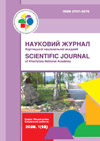UDC 376-056.263 CURRENT ASPECTS OF PROVIDING BARRIER-FREE EDUCATIONAL ENVIRONMENT FOR CHILDREN WITH COCHLEAR IMPLANTS
DOI : https://doi.org/10.51706/2707-3076-2025-12-12
Abstract
The purpose of the article is to identify and systematize relevant aspects of providing barrier-free educational environment for children with cochlear implants.
Research methods: theoretical analysis of the regulatory and legal field and scientific and methodological sources on the research issues, systematization of current aspects of ensuring a barrier-free educational environment for children with cochlear implants.
Results. The scientific understanding of the essence of the concept of "educational environment" and its components in the context of the auditory and speech development of children with cochlear implant systems is analyzed. The role of barrier-free space in meeting the special educational needs of children with cochlear implants is indicated. Environmental factors influencing the auditory and speech development of children with cochlear implants are identified and their effect on the micro- and macro-levels is revealed. The staged nature of the implementation of the environmental approach in the education of children with hearing impairments is noted, which is reflected in the tendency of scientific explorations to move from the theoretical to the practical plane and the shift of emphasis from pedagogical influence aimed at overcoming the secondary consequences of hearing impairment to the creation of internal and external prerequisites for their occurrence, taking into account the current, foreseeable needs of a child by his or her broad and immediate social environment.
Conclusions. The educational environment in a broad sense is both objective (physical arrangement) and social (attitudes, beliefs, values). One of the main characteristics of an educational environment conducive to the development of children with hearing impairments is its barrier-free nature. Cochlear implantation can be considered one of the modern effective means of ensuring social and communicative barrier-freeness for people with hearing impairments. Creating a barrier-free educational environment for children with cochlear implants involves regulatory support, a system of services for timely diagnosis of disorders, hearing aids, early assistance to the child and his/her family, variability and flexibility of the educational route in its institutional, technological, content, socio-communicative and speech-language components with support adequate to individual needs in the form of universal design, additional technical means that provide acoustic, informational, communicative accessibility, adaptations, modifications, etc.


